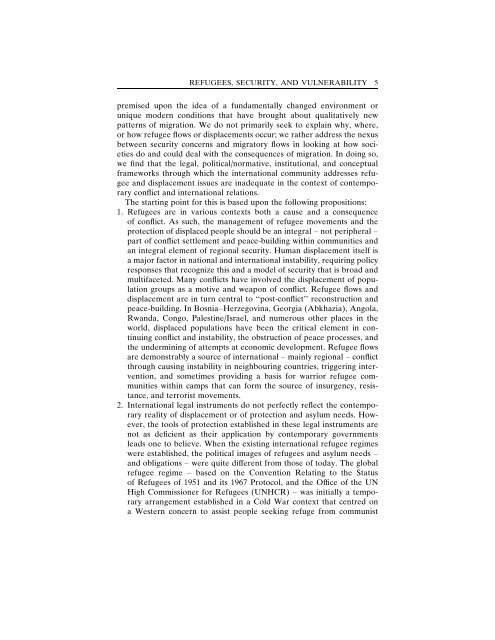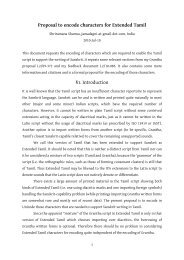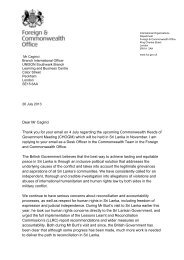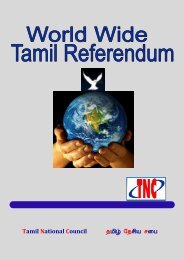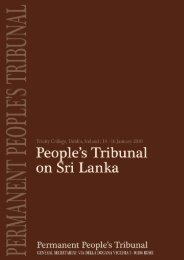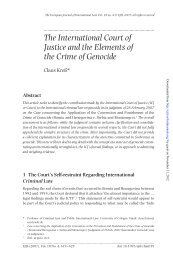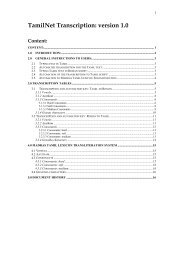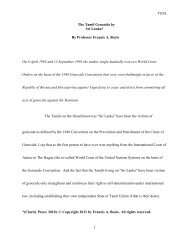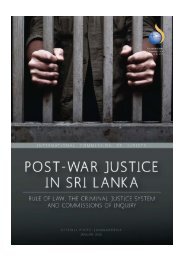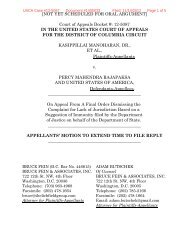Refugees and forced displacement - United Nations University
Refugees and forced displacement - United Nations University
Refugees and forced displacement - United Nations University
You also want an ePaper? Increase the reach of your titles
YUMPU automatically turns print PDFs into web optimized ePapers that Google loves.
REFUGEES, SECURITY, AND VULNERABILITY 5premised upon the idea of a fundamentally changed environment orunique modern conditions that have brought about qualitatively newpatterns of migration. We do not primarily seek to explain why, where,or how refugee flows or <strong>displacement</strong>s occur; we rather address the nexusbetween security concerns <strong>and</strong> migratory flows in looking at how societiesdo <strong>and</strong> could deal with the consequences of migration. In doing so,we find that the legal, political/normative, institutional, <strong>and</strong> conceptualframeworks through which the international community addresses refugee<strong>and</strong> <strong>displacement</strong> issues are inadequate in the context of contemporaryconflict <strong>and</strong> international relations.The starting point for this is based upon the following propositions:1. <strong>Refugees</strong> are in various contexts both a cause <strong>and</strong> a consequenceof conflict. As such, the management of refugee movements <strong>and</strong> theprotection of displaced people should be an integral – not peripheral –part of conflict settlement <strong>and</strong> peace-building within communities <strong>and</strong>an integral element of regional security. Human <strong>displacement</strong> itself isa major factor in national <strong>and</strong> international instability, requiring policyresponses that recognize this <strong>and</strong> a model of security that is broad <strong>and</strong>multifaceted. Many conflicts have involved the <strong>displacement</strong> of populationgroups as a motive <strong>and</strong> weapon of conflict. Refugee flows <strong>and</strong><strong>displacement</strong> are in turn central to ‘‘post-conflict’’ reconstruction <strong>and</strong>peace-building. In Bosnia–Herzegovina, Georgia (Abkhazia), Angola,Rw<strong>and</strong>a, Congo, Palestine/Israel, <strong>and</strong> numerous other places in theworld, displaced populations have been the critical element in continuingconflict <strong>and</strong> instability, the obstruction of peace processes, <strong>and</strong>the undermining of attempts at economic development. Refugee flowsare demonstrably a source of international – mainly regional – conflictthrough causing instability in neighbouring countries, triggering intervention,<strong>and</strong> sometimes providing a basis for warrior refugee communitieswithin camps that can form the source of insurgency, resistance,<strong>and</strong> terrorist movements.2. International legal instruments do not perfectly reflect the contemporaryreality of <strong>displacement</strong> or of protection <strong>and</strong> asylum needs. However,the tools of protection established in these legal instruments arenot as deficient as their application by contemporary governmentsleads one to believe. When the existing international refugee regimeswere established, the political images of refugees <strong>and</strong> asylum needs –<strong>and</strong> obligations – were quite different from those of today. The globalrefugee regime – based on the Convention Relating to the Statusof <strong>Refugees</strong> of 1951 <strong>and</strong> its 1967 Protocol, <strong>and</strong> the Office of the UNHigh Commissioner for <strong>Refugees</strong> (UNHCR) – was initially a temporaryarrangement established in a Cold War context that centred ona Western concern to assist people seeking refuge from communist


